- About This Guide
-
- Information about AAA
- Configuring the Local Database for AAA
- Configuring RADIUS Servers for AAA
- Configuring TACACS+ Servers for AAA
- Configuring LDAP Servers for AAA
- Configuring Windows NT Servers for AAA
- Configuring the Identity Firewall
- Configuring the ASA to Integrate with Cisco TrustSec
- Configuring Digital Certificates
- Index
- Information About Security Contexts
Configuring Multiple Context Mode
This chapter describes how to configure multiple security contexts on the ASA and includes the following sections:
- Information About Security Contexts
- Licensing Requirements for Multiple Context Mode
- Guidelines and Limitations
- Default Settings
- Configuring Multiple Contexts
- Changing Between Contexts and the System Execution Space
- Managing Security Contexts
- Monitoring Security Contexts
- Feature History for Multiple Context Mode
Information About Security Contexts
You can partition a single ASA into multiple virtual devices, known as security contexts. Each context acts as an independent device, with its own security policy, interfaces, and administrators. Multiple contexts are similar to having multiple standalone devices. For unsupported features in multiple context mode, see the “Guidelines and Limitations” section.
This section provides an overview of security contexts and includes the following topics:
- Common Uses for Security Contexts
- Context Configuration Files
- How the ASA Classifies Packets
- Cascading Security Contexts
- Management Access to Security Contexts
- Information About Resource Management
- Information About MAC Addresses
Common Uses for Security Contexts
You might want to use multiple security contexts in the following situations:
- You are a service provider and want to sell security services to many customers. By enabling multiple security contexts on the ASA, you can implement a cost-effective, space-saving solution that keeps all customer traffic separate and secure, and also eases configuration.
- You are a large enterprise or a college campus and want to keep departments completely separate.
- You are an enterprise that wants to provide distinct security policies to different departments.
- You have any network that requires more than one ASA.
Context Configuration Files
This section describes how the ASA implements multiple context mode configurations and includes the following topics:
Context Configurations
For each context, the ASA includes a configuration that identifies the security policy, interfaces, and all the options you can configure on a standalone device. You can store context configurations in flash memory, or you can download them from a TFTP, FTP, or HTTP(S) server.
System Configuration
The system administrator adds and manages contexts by configuring each context configuration location, allocated interfaces, and other context operating parameters in the system configuration, which, like a single mode configuration, is the startup configuration. The system configuration identifies basic settings for the ASA. The system configuration does not include any network interfaces or network settings for itself; rather, when the system needs to access network resources (such as downloading the contexts from the server), it uses one of the contexts that is designated as the admin context . The system configuration does include a specialized failover interface for failover traffic only.
Admin Context Configuration
The admin context is just like any other context, except that when a user logs in to the admin context, then that user has system administrator rights and can access the system and all other contexts. The admin context is not restricted in any way, and can be used as a regular context. However, because logging into the admin context grants you administrator privileges over all contexts, you might need to restrict access to the admin context to appropriate users. The admin context must reside on flash memory, and not remotely.
If your system is already in multiple context mode, or if you convert from single mode, the admin context is created automatically as a file on the internal flash memory called admin.cfg. This context is named “admin.” If you do not want to use admin.cfg as the admin context, you can change the admin context.
How the ASA Classifies Packets
Each packet that enters the ASA must be classified, so that the ASA can determine to which context to send a packet. This section includes the following topics:

Note![]() If the destination MAC address is a multicast or broadcast MAC address, the packet is duplicated and delivered to each context.
If the destination MAC address is a multicast or broadcast MAC address, the packet is duplicated and delivered to each context.
Valid Classifier Criteria
This section describes the criteria used by the classifier and includes the following topics:

Note![]() For management traffic destined for an interface, the interface IP address is used for classification.
For management traffic destined for an interface, the interface IP address is used for classification.
The routing table is not used for packet classification.
Unique Interfaces
If only one context is associated with the ingress interface, the ASA classifies the packet into that context. In transparent firewall mode, unique interfaces for contexts are required, so this method is used to classify packets at all times.
Unique MAC Addresses
If multiple contexts share an interface, then the classifier uses unique MAC addresses assigned to the interface in each context. An upstream router cannot route directly to a context without unique MAC addresses. By default, auto-generation of MAC addresses is enabled. You can also set the MAC addresses manually when you configure each interface.
NAT Configuration
If you disable use of unique MAC addresses, then the ASA uses the mapped addresses in your NAT configuration to classify packets. We recommend using MAC addresses instead of NAT, so that traffic classification can occur regardless of the completeness of the NAT configuration.
Classification Examples
Figure 8-1 shows multiple contexts sharing an outside interface. The classifier assigns the packet to Context B because Context B includes the MAC address to which the router sends the packet.
Figure 8-1 Packet Classification with a Shared Interface Using MAC Addresses
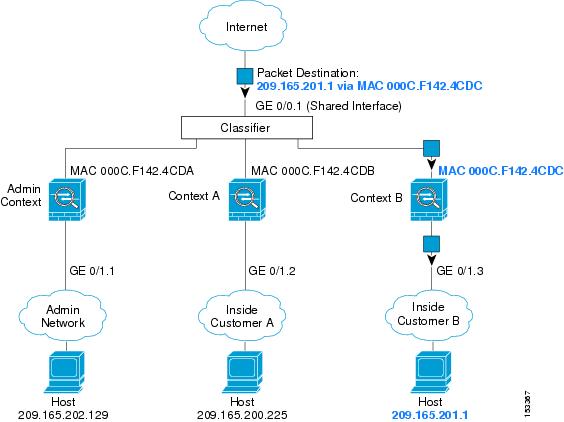
Note that all new incoming traffic must be classified, even from inside networks. Figure 8-2 shows a host on the Context B inside network accessing the Internet. The classifier assigns the packet to Context B because the ingress interface is Gigabit Ethernet 0/1.3, which is assigned to Context B.
Figure 8-2 Incoming Traffic from Inside Networks
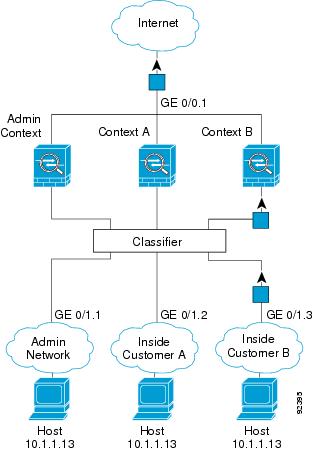
For transparent firewalls, you must use unique interfaces. Figure 8-3 shows a packet destined to a host on the Context B inside network from the Internet. The classifier assigns the packet to Context B because the ingress interface is Gigabit Ethernet 1/0.3, which is assigned to Context B.
Figure 8-3 Transparent Firewall Contexts
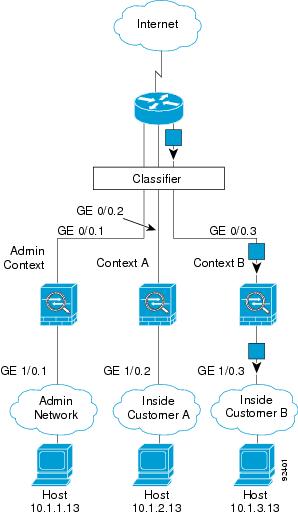
Cascading Security Contexts
Placing a context directly in front of another context is called cascading contexts ; the outside interface of one context is the same interface as the inside interface of another context. You might want to cascade contexts if you want to simplify the configuration of some contexts by configuring shared parameters in the top context.

Note![]() Cascading contexts requires unique MAC addresses for each context interface (the default setting). Because of the limitations of classifying packets on shared interfaces without MAC addresses, we do not recommend using cascading contexts without unique MAC addresses.
Cascading contexts requires unique MAC addresses for each context interface (the default setting). Because of the limitations of classifying packets on shared interfaces without MAC addresses, we do not recommend using cascading contexts without unique MAC addresses.
Figure 8-4 shows a gateway context with two contexts behind the gateway.
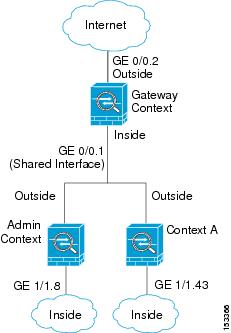
Management Access to Security Contexts
The ASA provides system administrator access in multiple context mode as well as access for individual context administrators. The following sections describe logging in as a system administrator or as a context administrator:
System Administrator Access
You can access the ASA as a system administrator in two ways:
From the console, you access the system execution space , which means that any commands you enter affect only the system configuration or the running of the system (for run-time commands).
See “Configuring Management Access,” to enable Telnet, SSH, and ASDM access.
As the system administrator, you can access all contexts.
When you change to a context from admin or the system, your username changes to the default “enable_15” username. If you configured command authorization in that context, you need to either configure authorization privileges for the “enable_15” user, or you can log in as a different name for which you provide sufficient privileges. To log in with a new username, enter the login command. For example, you log in to the admin context with the username “admin.” The admin context does not have any command authorization configuration, but all other contexts include command authorization. For convenience, each context configuration includes a user “admin” with maximum privileges. When you change from the admin context to context A, your username is altered to enable_15, so you must log in again as “admin” by entering the login command. When you change to context B, you must again enter the login command to log in as “admin.”
The system execution space does not support any AAA commands, but you can configure its own enable password, as well as usernames in the local database to provide individual logins.
Context Administrator Access
You can access a context using Telnet, SSH, or ASDM. If you log in to a non-admin context, you can only access the configuration for that context. You can provide individual logins to the context. See “Configuring Management Access,” to enable Telnet, SSH, and ASDM access and to configure management authentication.
Information About Resource Management
By default, all security contexts have unlimited access to the resources of the ASA, except where maximum limits per context are enforced; the only exception is VPN resources, which are disabled by default. If you find that one or more contexts use too many resources, and they cause other contexts to be denied connections, for example, then you can configure resource management to limit the use of resources per context. For VPN resources, you must configure resource management to allow any VPN tunnels.
Resource Classes
The ASA manages resources by assigning contexts to resource classes. Each context uses the resource limits set by the class. To use the settings of a class, assign the context to the class when you define the context. All contexts belong to the default class if they are not assigned to another class; you do not have to actively assign a context to default. You can only assign a context to one resource class. The exception to this rule is that limits that are undefined in the member class are inherited from the default class; so in effect, a context could be a member of default plus another class.
Resource Limits
You can set the limit for individual resources as a percentage (if there is a hard system limit) or as an absolute value.
For most resources, the ASA does not set aside a portion of the resources for each context assigned to the class; rather, the ASA sets the maximum limit for a context. If you oversubscribe resources, or allow some resources to be unlimited, a few contexts can “use up” those resources, potentially affecting service to other contexts. The exception is VPN resource types, which you cannot oversubscribe, so the resources assigned to each context are guaranteed. To accommodate temporary bursts of VPN sessions beyond the amount assigned, the ASA supports a “burst” VPN resource type, which is equal to the remaining unassigned VPN sessions. The burst sessions can be oversubscribed, and are available to contexts on a first-come, first-served basis.
Default Class
All contexts belong to the default class if they are not assigned to another class; you do not have to actively assign a context to the default class.
If a context belongs to a class other than the default class, those class settings always override the default class settings. However, if the other class has any settings that are not defined, then the member context uses the default class for those limits. For example, if you create a class with a 2 percent limit for all concurrent connections, but no other limits, then all other limits are inherited from the default class. Conversely, if you create a class with a limit for all resources, the class uses no settings from the default class.
For most resources, the default class provides unlimited access to resources for all contexts, except for the following limits:
- Telnet sessions—5 sessions. (The maximum per context.)
- SSH sessions—5 sessions. (The maximum per context.)
- IPsec sessions—5 sessions. (The maximum per context.)
- MAC addresses—65,535 entries. (The maximum per context.)
- VPN site-to-site tunnels—0 sessions. (You must manually configure the class to allow any VPN sessions.)
Figure 8-5 shows the relationship between the default class and other classes. Contexts A and C belong to classes with some limits set; other limits are inherited from the default class. Context B inherits no limits from default because all limits are set in its class, the Gold class. Context D was not assigned to a class, and is by default a member of the default class.
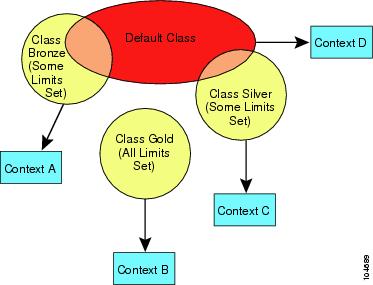
Using Oversubscribed Resources
You can oversubscribe the ASA by assigning more than 100 percent of a resource across all contexts (with the exception of non-burst VPN resources). For example, you can set the Bronze class to limit connections to 20 percent per context, and then assign 10 contexts to the class for a total of 200 percent. If contexts concurrently use more than the system limit, then each context gets less than the 20 percent you intended. (See Figure 8-6.)
Figure 8-6 Resource Oversubscription
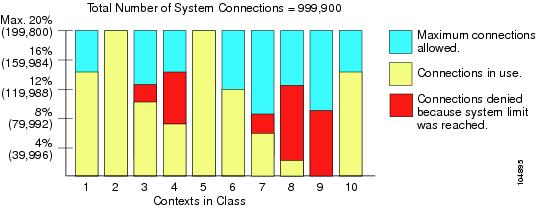
Using Unlimited Resources
The ASA lets you assign unlimited access to one or more resources in a class, instead of a percentage or absolute number. When a resource is unlimited, contexts can use as much of the resource as the system has available. For example, Context A, B, and C are in the Silver Class, which limits each class member to 1 percent of the connections, for a total of 3 percent; but the three contexts are currently only using 2 percent combined. Gold Class has unlimited access to connections. The contexts in the Gold Class can use more than the 97 percent of “unassigned” connections; they can also use the 1 percent of connections not currently in use by Context A, B, and C, even if that means that Context A, B, and C are unable to reach their 3 percent combined limit. (See Figure 8-7.) Setting unlimited access is similar to oversubscribing the ASA, except that you have less control over how much you oversubscribe the system.
Figure 8-7 Unlimited Resources
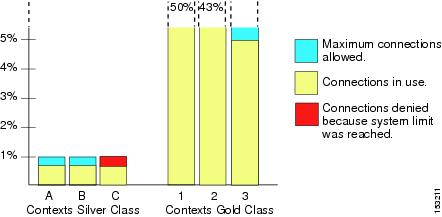
Information About MAC Addresses
To allow contexts to share interfaces, the ASA assigns virtual MAC addresses to each shared context interface by default. To customize or disable auto-generation, see the “Automatically Assigning MAC Addresses to Context Interfaces” section.
The MAC address is used to classify packets within a context. If you share an interface, but do not have unique MAC addresses for the interface in each context, then other classification methods are attempted that might not provide full coverage. See the “How the ASA Classifies Packets” section for information about classifying packets.
In the rare circumstance that the generated MAC address conflicts with another private MAC address in your network, you can manually set the MAC address for the interface within the context. See the “Configuring the MAC Address, MTU, and TCP MSS” section to manually set the MAC address.
Default MAC Address
(8.5(1.7) and Later) Automatic MAC address generation is enabled by default. The ASA autogenerates the prefix based on the last two bytes of the interface (ASA 5500) or backplane (ASASM) MAC address. You can customize the prefix if desired.
If you disable MAC address generation, see the following default MAC addresses:
- For the ASA 5500 series appliances—The physical interface uses the burned-in MAC address, and all subinterfaces of a physical interface use the same burned-in MAC address.
- For the ASASM—All VLAN interfaces use the same MAC address, derived from the backplane MAC address.
See also the “MAC Address Format” section.

Note![]() (8.5(1.6) and earlier) To maintain hitless upgrade for failover pairs, the ASA does not convert an existing legacy auto-generation configuration upon a reload if failover is enabled. However, we strongly recommend that you manually change to the prefix method of generation when using failover, especially for the ASASM. Without the prefix method, ASASMs installed in different slot numbers experience a MAC address change upon failover, and can experience traffic interruption. After upgrading, to use the prefix method of MAC address generation, reenable MAC address autogeneration to use a prefix. For more information about the legacy method, see the mac-address auto command in the command reference.
(8.5(1.6) and earlier) To maintain hitless upgrade for failover pairs, the ASA does not convert an existing legacy auto-generation configuration upon a reload if failover is enabled. However, we strongly recommend that you manually change to the prefix method of generation when using failover, especially for the ASASM. Without the prefix method, ASASMs installed in different slot numbers experience a MAC address change upon failover, and can experience traffic interruption. After upgrading, to use the prefix method of MAC address generation, reenable MAC address autogeneration to use a prefix. For more information about the legacy method, see the mac-address auto command in the command reference.
Interaction with Manual MAC Addresses
If you manually assign a MAC address and also enable auto-generation, then the manually assigned MAC address is used. If you later remove the manual MAC address, the auto-generated address is used.
Because auto-generated addresses (when using a prefix) start with A2, you cannot start manual MAC addresses with A2 if you also want to use auto-generation.
Failover MAC Addresses
For use with failover, the ASA generates both an active and standby MAC address for each interface. If the active unit fails over and the standby unit becomes active, the new active unit starts using the active MAC addresses to minimize network disruption. See the “MAC Address Format” section section for more information.
MAC Address Format
The ASA generates the MAC address using the following format:
Where xx.yy is a user-defined prefix or an autogenerated prefix based on the last two bytes of the interface (ASA 5500) or backplane (ASASM) MAC address, and zz.zzzz is an internal counter generated by the ASA. For the standby MAC address, the address is identical except that the internal counter is increased by 1.
For an example of how the prefix is used, if you set a prefix of 77, then the ASA converts 77 into the hexadecimal value 004D ( yyxx ). When used in the MAC address, the prefix is reversed ( xxyy ) to match the ASA native form:
For a prefix of 1009 (03F1), the MAC address is:

Note![]() The MAC address format without a prefix is a legacy version not supported on newer ASA versions. See the mac-address auto command in the command reference for more information about the legacy format.
The MAC address format without a prefix is a legacy version not supported on newer ASA versions. See the mac-address auto command in the command reference for more information about the legacy format.
Licensing Requirements for Multiple Context Mode
|
|
|
|---|---|
Prerequisites
After you are in multiple context mode, connect tothe admin context to access the system configuration. You cannot configure the system from a non-admin context. By default, after you enable multiple context mode, you can connect to the admin context by using the default management IP address. See “Getting Started,” for more information about connecting to the ASA.
Guidelines and Limitations
This section includes the guidelines and limitations for this feature.
Supported in routed and transparent firewall mode; set the firewall mode per context.
Active/Active mode failover is only supported in multiple context mode.
Does not support the ASA 5505.
Multiple context mode does not support the following features:
- RIP
- OSPFv3. (OSPFv2 is supported.)
- Multicast routing
- Threat Detection
- Unified Communications
- QoS
- Remote access VPN. (Site-to-site VPN is supported.)
- The context mode (single or multiple) is not stored in the configuration file, even though it does endure reboots. If you need to copy your configuration to another device, set the mode on the new device to match.
- If you store context configurations in the root directory of flash memory, on some models you might run out of room in that directory, even though there is available memory. In this case, create a subdirectory for your configuration files. Background: some models, such as the ASA 5585-X, use the FAT 16 file system for internal flash memory, and if you do not use 8.3-compliant short names, or use uppercase characters, then fewer than 512 files and folders can be stored because the file system uses up slots to store long file names (see http://support.microsoft.com/kb/120138/en-us ).
Default Settings
- By default, the ASA is in single context mode.
- See the “Default Class” section.
- See the “Default MAC Address” section.
Configuring Multiple Contexts
This section describes how to configure multiple context mode and includes the following topics:
- Task Flow for Configuring Multiple Context Mode
- Enabling or Disabling Multiple Context Mode
- Configuring a Class for Resource Management
- Configuring a Security Context
- Automatically Assigning MAC Addresses to Context Interfaces
Task Flow for Configuring Multiple Context Mode
To configure multiple context mode, perform the following steps:
Step 1![]() Enable multiple context mode. See the “Enabling or Disabling Multiple Context Mode” section.
Enable multiple context mode. See the “Enabling or Disabling Multiple Context Mode” section.
Step 2![]() (Optional) Configure classes for resource management. See the “Configuring a Class for Resource Management” section. Note : For VPN support, you must configure VPN resources in a resource class; the default class does not allow VPN.
(Optional) Configure classes for resource management. See the “Configuring a Class for Resource Management” section. Note : For VPN support, you must configure VPN resources in a resource class; the default class does not allow VPN.
Step 3![]() Configure interfaces in the system execution space.
Configure interfaces in the system execution space.
Step 4![]() Configure security contexts. See the “Configuring a Security Context” section.
Configure security contexts. See the “Configuring a Security Context” section.
Step 5![]() (Optional) Customize MAC address assignments. See the “Automatically Assigning MAC Addresses to Context Interfaces” section.
(Optional) Customize MAC address assignments. See the “Automatically Assigning MAC Addresses to Context Interfaces” section.
Step 6![]() Complete interface configuration in the context. See “Completing Interface Configuration (Routed Mode),” or Chapter14, “Completing Interface Configuration (Transparent Mode, 8.4 and Later)”
Complete interface configuration in the context. See “Completing Interface Configuration (Routed Mode),” or Chapter14, “Completing Interface Configuration (Transparent Mode, 8.4 and Later)”
Enabling or Disabling Multiple Context Mode
Your ASA might already be configured for multiple security contexts depending on how you ordered it from Cisco. If you need to convert from single mode to multiple mode, follow the procedures in this section.
ASDM supports changing modes from single to multiple mode if you use the High Availability and Scalability Wizard and you enable Active/Active failover. See “Configuring Failover,” for more information. If you do not want to use Active/Active failover or want to change back to single mode, you must change modes using the CLI; because changing modes requires confirmation, you cannot use the Command Line Interface tool. This section describes changing modes at the CLI.
Enabling Multiple Context Mode
When you convert from single mode to multiple mode, the ASA converts the running configuration into two files: a new startup configuration that comprises the system configuration, and admin.cfg that comprises the admin context (in the root directory of the internal flash memory). The original running configuration is saved as old_running.cfg (in the root directory of the internal flash memory). The original startup configuration is not saved. The ASA automatically adds an entry for the admin context to the system configuration with the name “admin.”
Prerequisites
Back up your startup configuration. When you convert from single mode to multiple mode, the ASA converts the running configuration into two files. The original startup configuration is not saved. See the “Managing Files” section.
Detailed Steps
|
|
|
|---|---|
|
|
Changes to multiple context mode. You are prompted to reboot the ASA. |
Restoring Single Context Mode
To copy the old running configuration to the startup configuration and to change the mode to single mode, perform the following steps.
Prerequisites
Detailed Steps
Configuring a Class for Resource Management
To configure a class in the system configuration, perform the following steps. You can change the value of a particular resource limit by reentering the command with a new value.
Prerequisites
Guidelines
Table 8-1 lists the resource types and the limits.
|
|
|
|
|
|
|---|---|---|---|---|
| Note ASDM sessions use two HTTPS connections: one for monitoring that is always present, and one for making configuration changes that is present only when you make changes. For example, the system limit of 32 ASDM sessions represents a limit of 64 HTTPS sessions. |
||||
| Conns/sec2 |
Concurrent connections: See the “Supported Feature Licenses Per Model” section for the connection limit available for your model. |
TCP or UDP connections between any two hosts, including connections between one host and multiple other hosts. |
||
For transparent firewall mode, the number of MAC addresses allowed in the MAC address table. |
||||
The Other VPN session amount for your model minus the sum of the sessions assigned to all contexts for Site-to-Site VPN. |
The number of site-to-site VPN sessions allowed beyond the amount assigned to a context with Site-to-Site VPN. For example, if your model supports 5000 sessions, and you assign 4000 sessions across all contexts with Site-to-Site VPN, then the remaining 1000 sessions are available for Site-to-Site VPN Burst. Unlike Site-to-Site VPN, which guarantees the sessions to the context, Site-to-Site VPN Burst can be oversubscribed; the burst pool is available to all contexts on a first-come, first-served basis. |
|||
See the “Supported Feature Licenses Per Model” section for the Other VPN sessions available for your model. |
Site-to-site VPN sessions. You cannot oversubscribe this resource; all context assignments combined cannot exceed the model limit. The sessions you assign for this resource are guaranteed to the context. |
|||
xlates 2 |
Detailed Steps
Step 1![]() If you are not already in the System configuration mode, in the Device List pane, double-click System
If you are not already in the System configuration mode, in the Device List pane, double-click System![]() under the active device IP address.
under the active device IP address.
Step 2![]() Choose Configuration > Context Management > Resource Class , and click Add .
Choose Configuration > Context Management > Resource Class , and click Add .
The Add Resource Class dialog box appears.
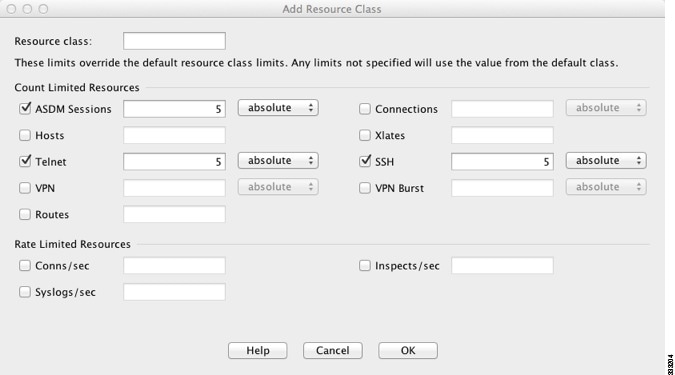
Step 3![]() In the Resource Class field, enter a class name up to 20 characters in length.
In the Resource Class field, enter a class name up to 20 characters in length.
Step 4![]() In the Count Limited Resources area, set the concurrent limits for resources.
In the Count Limited Resources area, set the concurrent limits for resources.
See the Table 8-1 for a description of each resource type.
For resources that do not have a system limit, you cannot set the percentage; you can only set an absolute value. If you do not set a limit, the limit is inherited from the default class. If the default class does not set a limit, then the resource is unlimited, or the system limit if available. For most resources, 0 sets the limit to unlimited. For VPN types, 0 sets the limit none.
Step 5![]() In the Rate Limited Resources area, set the rate limit for resources.
In the Rate Limited Resources area, set the rate limit for resources.
See the Table 8-1 for a description of each resource type.
If you do not set a limit, the limit is inherited from the default class. If the default class does not set a limit, then it is unlimited by default. 0 sets the limit to unlimited
Configuring a Security Context
The security context definition in the system configuration identifies the context name, configuration file URL, interfaces that a context can use, and other settings.
Prerequisites
- Perform this procedure in the system execution space.
- For the ASASM, assign VLANs to the ASASM on the switch according to Chapter2, “Configuring the Switch for Use with the ASA Services Module”
- For the ASA 5500, configure physical interface parameters, VLAN subinterfaces, EtherChannels, and redundant interfaces according to Chapter11, “Starting Interface Configuration (ASA 5510 and Higher)”
Detailed Steps
Step 1![]() If you are not already in the System configuration mode, in the Device List pane, double-click System
If you are not already in the System configuration mode, in the Device List pane, double-click System![]() under the active device IP address.
under the active device IP address.
Step 2![]() Choose Configuration > Context Management > Security Contexts , and click Add .
Choose Configuration > Context Management > Security Contexts , and click Add .
The Add Context dialog box appears.
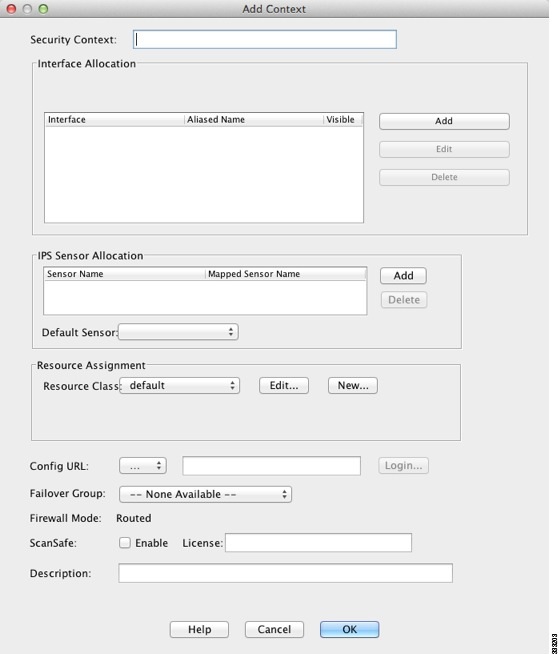
Step 3![]() In the Security Context field, enter the context name as a string up to 32 characters long.
In the Security Context field, enter the context name as a string up to 32 characters long.
This name is case sensitive, so you can have two contexts named “customerA” and “CustomerA,” for example. “System” or “Null” (in upper or lower case letters) are reserved names, and cannot be used.
Step 4![]() In the Interface Allocation area, click the Add button to assign an interface to the context.
In the Interface Allocation area, click the Add button to assign an interface to the context.
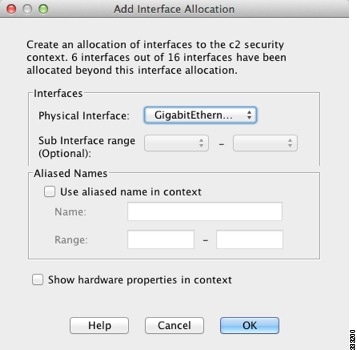
a.![]() From the Interfaces > Physical Interface drop-down list, choose an interface.
From the Interfaces > Physical Interface drop-down list, choose an interface.
You can assign the main interface, in which case you leave the subinterface ID blank, or you can assign a subinterface or a range of subinterfaces associated with this interface. In transparent firewall mode, only interfaces that have not been allocated to other contexts are shown. If the main interface was already assigned to another context, then you must choose a subinterface.
b.![]() (Optional) In the Interfaces > Subinterface Range (optional) drop-down list, choose a subinterface ID.
(Optional) In the Interfaces > Subinterface Range (optional) drop-down list, choose a subinterface ID.
For a range of subinterface IDs, choose the ending ID in the second drop-down list, if available.
In transparent firewall mode, only subinterfaces that have not been allocated to other contexts are shown.
a.![]() (Optional) In the Aliased Names area, check Use Aliased Name in Context to set an aliased name for this interface to be used in the context configuration instead of the interface ID.
(Optional) In the Aliased Names area, check Use Aliased Name in Context to set an aliased name for this interface to be used in the context configuration instead of the interface ID.
–![]() In the Name field, sets the aliased name.
In the Name field, sets the aliased name.
An aliased name must start with a letter, end with a letter, and have as interior characters only letters, digits, or an underscore. This field lets you specify a name that ends with a letter or underscore; to add an optional digit after the name, set the digit in the Range field.
–![]() (Optional) In the Range field, set the numeric suffix for the aliased name.
(Optional) In the Range field, set the numeric suffix for the aliased name.
If you have a range of subinterfaces, you can enter a range of digits to be appended to the name.
b.![]() (Optional) To enable context users to see physical interface properties even if you set an aliased name, check Show Hardware Properties in Context .
(Optional) To enable context users to see physical interface properties even if you set an aliased name, check Show Hardware Properties in Context .
c.![]() Click OK to return to the Add Context dialog box.
Click OK to return to the Add Context dialog box.
Step 5![]() (Optional) If you use IPS virtual sensors, then assign a sensor to the context in the IPS Sensor Allocation area.
(Optional) If you use IPS virtual sensors, then assign a sensor to the context in the IPS Sensor Allocation area.
For detailed information about IPS and virtual sensors, see Chapter 31, “Configuring the ASA IPS Module,” in the firewall configuration guide.
Step 6![]() (Optional) To assign this context to a resource class, choose a class name from the Resource Assignment > Resource Class drop-down list.
(Optional) To assign this context to a resource class, choose a class name from the Resource Assignment > Resource Class drop-down list.
You can add or edit a resource class directly from this area. See the “Configuring a Class for Resource Management” section for more information.
Step 7![]() To set the context configuration location, identify the URL by choosing a file system type from the Config URL drop-down list and entering a path in the field.
To set the context configuration location, identify the URL by choosing a file system type from the Config URL drop-down list and entering a path in the field.
For example, the combined URL for FTP has the following format:
ftp://server.example.com/configs/admin.cfg
a.![]() (Optional) For external file systems, set the username and password by clicking Login .
(Optional) For external file systems, set the username and password by clicking Login .
Step 8![]() (Optional) To set the failover group for Active/Active failover, choose the group name in the Failover Group drop-down list.
(Optional) To set the failover group for Active/Active failover, choose the group name in the Failover Group drop-down list.
Step 9![]() (Optional) To enable ScanSafe inspection in this context, click Enable . To override the license set in the system
(Optional) To enable ScanSafe inspection in this context, click Enable . To override the license set in the system![]() configuration, enter a license in the License field.
configuration, enter a license in the License field.
Step 10![]() (Optional) Add a description in the Description field.
(Optional) Add a description in the Description field.
Step 11![]() Click OK to return to the Security Contexts pane.
Click OK to return to the Security Contexts pane.
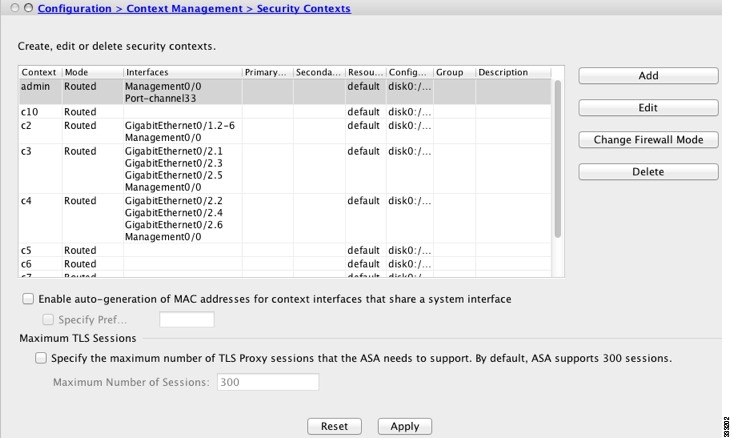
Step 12![]() (Optional) To set the firewall mode to transparent, select the context and click Change Firewall Mode .
(Optional) To set the firewall mode to transparent, select the context and click Change Firewall Mode .
You see the following confirmation dialog box:
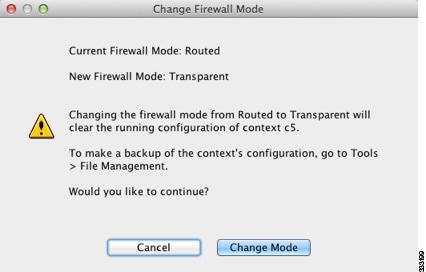
If this is a new context, there is no configuration to erase. Click Change Mode to change to transparent firewall mode.
If this is an existing context, then be sure to back up the configuration before you change the mode.

Note You cannot change the mode of the currently connected context in ASDM (typically the admin context); see the “Setting the Firewall Mode (Single Mode)” section to set the mode at the command line.
Step 13![]() To customize auto-generation of MAC addresses, see the “Automatically Assigning MAC Addresses to Context Interfaces” section.
To customize auto-generation of MAC addresses, see the “Automatically Assigning MAC Addresses to Context Interfaces” section.
Step 14![]() To specify the maximum TLS Proxy sessions for the device, check the Specify the maximum number of TLS Proxy sessions that the ASA needs to support check box. For more information about TLS proxy, see Chapter 17, “Configuring the TLS Proxy for Encrypted Voice Inspection,” in the firewall configuration guide.
To specify the maximum TLS Proxy sessions for the device, check the Specify the maximum number of TLS Proxy sessions that the ASA needs to support check box. For more information about TLS proxy, see Chapter 17, “Configuring the TLS Proxy for Encrypted Voice Inspection,” in the firewall configuration guide.
Automatically Assigning MAC Addresses to Context Interfaces
This section describes how to configure auto-generation of MAC addresses.
The MAC address is used to classify packets within a context. See the “Information About MAC Addresses” section for more information, especially if you are upgrading from an earlier ASA version. See also the “Viewing Assigned MAC Addresses” section.
Guidelines
- When you configure a name for the interface in a context, the new MAC address is generated immediately. If you enable this feature after you configure context interfaces, then MAC addresses are generated for all interfaces immediately after you enable it. If you disable this feature, the MAC address for each interface reverts to the default MAC address. For example, subinterfaces of GigabitEthernet 0/1 revert to using the MAC address of GigabitEthernet 0/1.
- In the rare circumstance that the generated MAC address conflicts with another private MAC address in your network, you can manually set the MAC address for the interface within the context. See the “Configuring the MAC Address, MTU, and TCP MSS” section to manually set the MAC address.
Detailed Steps
Step 1![]() If you are not already in the System configuration mode, in the Device List pane, double-click System
If you are not already in the System configuration mode, in the Device List pane, double-click System![]() under the active device IP address.
under the active device IP address.
Step 2![]() Choose Configuration > Context Management > Security Contexts , and check Mac-Address auto . If you do not enter a prefix, then the ASA autogenerates the prefix based on the last two bytes of the interface (ASA 5500) or backplane (ASASM) MAC address.
Choose Configuration > Context Management > Security Contexts , and check Mac-Address auto . If you do not enter a prefix, then the ASA autogenerates the prefix based on the last two bytes of the interface (ASA 5500) or backplane (ASASM) MAC address.
Step 3![]() (Optional) Check the Prefix check box, and in the field, enter a decimal value between 0 and 65535.
(Optional) Check the Prefix check box, and in the field, enter a decimal value between 0 and 65535.
This prefix is converted to a four-digit hexadecimal number, and used as part of the MAC address. See the “MAC Address Format” section section for more information about how the prefix is used.
Changing Between Contexts and the System Execution Space
If you log in to the system execution space (or the admin context), you can change between contexts and perform configuration and monitoring tasks within each context. The running configuration that you edit in a configuration mode depends on your location. When you are in the system execution space, the running configuration consists only of the system configuration; when you are in a context, the running configuration consists only of that context.
Detailed Steps
Step 1![]() To configure the System, in the Device List pane, double-click System
To configure the System, in the Device List pane, double-click System![]() under the active device IP address.
under the active device IP address.
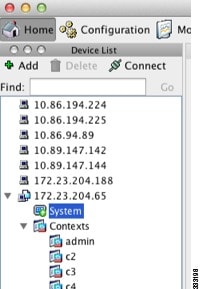
Step 2![]() To configure a context, in the Device List pane, double-click the context name under the active device IP address.
To configure a context, in the Device List pane, double-click the context name under the active device IP address.
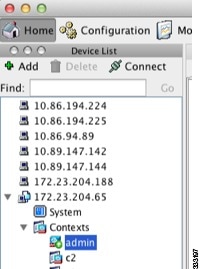
Managing Security Contexts
This section describes how to manage security contexts and includes the following topics:
- Removing a Security Context
- Changing the Admin Context
- Changing the Security Context URL
- Reloading a Security Context
Removing a Security Context
You cannot remove the current admin context.

Note![]() If you use failover, there is a delay between when you remove the context on the active unit and when the context is removed on the standby unit.
If you use failover, there is a delay between when you remove the context on the active unit and when the context is removed on the standby unit.
Prerequisites
Detailed Steps
Step 1![]() If you are not already in the System configuration mode, in the Device List pane, double-click System
If you are not already in the System configuration mode, in the Device List pane, double-click System![]() under the active device IP address.
under the active device IP address.
Step 2![]() Choose Configuration > Context Management > Security Contexts .
Choose Configuration > Context Management > Security Contexts .
Step 3![]() Select the context you want to delete, and click Delete .
Select the context you want to delete, and click Delete .
The Delete Context dialog box appears.
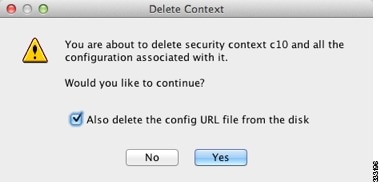
Step 4![]() If you might want to re-add this context later, and want to keep the configuration file for future use, uncheck the Also delete config URL file from the disk check box.
If you might want to re-add this context later, and want to keep the configuration file for future use, uncheck the Also delete config URL file from the disk check box.
If you want to delete the configuration file, then leave the check box checked.
Changing the Admin Context
The system configuration does not include any network interfaces or network settings for itself; rather, when the system needs to access network resources (such as downloading the contexts from the server), it uses one of the contexts that is designated as the admin context.
The admin context is just like any other context, except that when a user logs in to the admin context, then that user has system administrator rights and can access the system and all other contexts. The admin context is not restricted in any way, and can be used as a regular context. However, because logging into the admin context grants you administrator privileges over all contexts, you might need to restrict access to the admin context to appropriate users.

Note![]() For ASDM, you cannot change the admin context within ASDM because your ASDM session would disconnect. You can perform this procedure using the Command Line Interface tool noting that you will have to reconnect to the new admin context.
For ASDM, you cannot change the admin context within ASDM because your ASDM session would disconnect. You can perform this procedure using the Command Line Interface tool noting that you will have to reconnect to the new admin context.
Guidelines
You can set any context to be the admin context, as long as the configuration file is stored in the internal flash memory.
Prerequisites
Detailed Steps
Step 1![]() If you are not already in the System configuration mode, in the Device List pane, double-click System
If you are not already in the System configuration mode, in the Device List pane, double-click System![]() under the active device IP address.
under the active device IP address.
Step 2![]() Choose Tools > Command Line Interface .
Choose Tools > Command Line Interface .
The Command Line Interface dialog box appears.
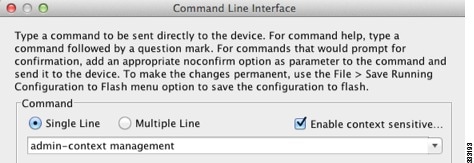
Step 3![]() Enter the following command:
Enter the following command:
Any remote management sessions, such as Telnet, SSH, or HTTPS (ASDM), that are connected to the admin context are terminated. You must reconnect to the new admin context.

Note A few system configuration commands, including ntp server, identify an interface name that belongs to the admin context. If you change the admin context, and that interface name does not exist in the new admin context, be sure to update any system commands that refer to the interface.
Changing the Security Context URL
Guidelines
- You cannot change the security context URL without reloading the configuration from the new URL. The ASA merges the new configuration with the current running configuration.
- Reentering the same URL also merges the saved configuration with the running configuration.
- A merge adds any new commands from the new configuration to the running configuration.
–![]() If the configurations are the same, no changes occur.
If the configurations are the same, no changes occur.
–![]() If commands conflict or if commands affect the running of the context, then the effect of the merge depends on the command. You might get errors, or you might have unexpected results. If the running configuration is blank (for example, if the server was unavailable and the configuration was never downloaded), then the new configuration is used.
If commands conflict or if commands affect the running of the context, then the effect of the merge depends on the command. You might get errors, or you might have unexpected results. If the running configuration is blank (for example, if the server was unavailable and the configuration was never downloaded), then the new configuration is used.
Prerequisites
Detailed Steps
Step 1![]() If you are not already in the System configuration mode, in the Device List pane, double-click System
If you are not already in the System configuration mode, in the Device List pane, double-click System![]() under the active device IP address.
under the active device IP address.
Step 2![]() Choose Configuration > Context Management > Security Contexts .
Choose Configuration > Context Management > Security Contexts .
Step 3![]() Select the context you want to edit, and click Edit .
Select the context you want to edit, and click Edit .
The Edit Context dialog box appears.

Step 4![]() Enter a new URL in the Config URL field, and click OK .
Enter a new URL in the Config URL field, and click OK .
The system immediately loads the context so that it is running.
Reloading a Security Context
You can reload the context in two ways:
This action clears most attributes associated with the context, such as connections and NAT tables.
This action clears additional attributes, such as memory allocation, which might be useful for troubleshooting. However, to add the context back to the system requires you to respecify the URL and interfaces.
Reloading by Clearing the Configuration
To reload the context by clearing the context configuration and reloading the configuration from the URL, perform the following steps.
Detailed Steps
Step 1![]() In the Device List pane, double-click the context name under the active device IP address.
In the Device List pane, double-click the context name under the active device IP address.
Step 2![]() Choose Tools > Command Line Interface .
Choose Tools > Command Line Interface .
The Command Line Interface dialog box appears.
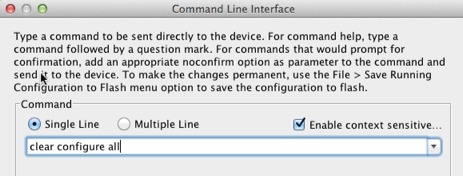
Step 3![]() Enter the following command:
Enter the following command:
The context configuration is cleared.
Step 5![]() Choose Tools > Command Line Interface again.
Choose Tools > Command Line Interface again.
The Command Line Interface dialog box appears.
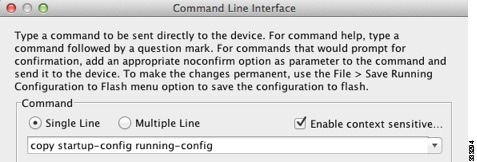
Step 6![]() Enter the following command:
Enter the following command:
The ASA reloads the configuration. The ASA copies the configuration from the URL specified in the system configuration. You cannot change the URL from within a context.
Reloading by Removing and Re-adding the Context
To reload the context by removing the context and then re-adding it, perform the steps in the following sections:
1.![]() “Removing a Security Context” section. Be sure to uncheck the Also delete config URL file from the disk check box.
“Removing a Security Context” section. Be sure to uncheck the Also delete config URL file from the disk check box.
Monitoring Security Contexts
This section describes how to view and monitor context information and includes the following topics:
Monitoring Context Resource Usage
To monitor resource usage of all contexts from the system execution space, perform the following steps:
Step 1![]() If you are not already in the System mode, in the Device List pane, double-click System
If you are not already in the System mode, in the Device List pane, double-click System![]() under the active device IP address.
under the active device IP address.
Step 2![]() Click the Monitoring button on the toolbar.
Click the Monitoring button on the toolbar.
Step 3![]() Click Context Resource Usage .
Click Context Resource Usage .
Click each resource type to view the resource usage for all contexts:
–![]() Context—Shows the name of each context.
Context—Shows the name of each context.
For each access method, see the following usage statistics:
–![]() Existing Connections (#)—Shows the number of existing connections.
Existing Connections (#)—Shows the number of existing connections.
–![]() Existing Connections (%)—Shows the connections used by this context as a percentage of the total number of connections used by all contexts.
Existing Connections (%)—Shows the connections used by this context as a percentage of the total number of connections used by all contexts.
–![]() Peak Connections (#)—Shows the peak number of connections since the statistics were last cleared, either using the clear resource usage command or because the device rebooted.
Peak Connections (#)—Shows the peak number of connections since the statistics were last cleared, either using the clear resource usage command or because the device rebooted.
–![]() Context—Shows the name of each context.
Context—Shows the name of each context.
–![]() Existing Connections (#)—Shows the number of existing connections.
Existing Connections (#)—Shows the number of existing connections.
–![]() Existing Connections (%)—Shows the connections used by this context as a percentage of the total number of connections used by all contexts.
Existing Connections (%)—Shows the connections used by this context as a percentage of the total number of connections used by all contexts.
–![]() Peak Connections (#)—Shows the peak number of connections since the statistics were last cleared, either using the clear resource usage command or because the device rebooted.
Peak Connections (#)—Shows the peak number of connections since the statistics were last cleared, either using the clear resource usage command or because the device rebooted.
–![]() Context—Shows the name of each context.
Context—Shows the name of each context.
–![]() Xlates (#)—Shows the number of current xlates.
Xlates (#)—Shows the number of current xlates.
–![]() Xlates (%)—Shows the xlates used by this context as a percentage of the total number of xlates used by all contexts.
Xlates (%)—Shows the xlates used by this context as a percentage of the total number of xlates used by all contexts.
–![]() Peak (#)—Shows the peak number of xlates since the statistics were last cleared, either using the clear resource usage command or because the device rebooted.
Peak (#)—Shows the peak number of xlates since the statistics were last cleared, either using the clear resource usage command or because the device rebooted.
–![]() Context—Shows the name of each context.
Context—Shows the name of each context.
–![]() NATs (#)—Shows the current number of NAT rules.
NATs (#)—Shows the current number of NAT rules.
–![]() NATs (%)—Shows the NAT rules used by this context as a percentage of the total number of NAT rules used by all contexts.
NATs (%)—Shows the NAT rules used by this context as a percentage of the total number of NAT rules used by all contexts.
–![]() Peak NATs (#)—Shows the peak number of NAT rules since the statistics were last cleared, either using the clear resource usage command or because the device rebooted.
Peak NATs (#)—Shows the peak number of NAT rules since the statistics were last cleared, either using the clear resource usage command or because the device rebooted.
–![]() Context—Shows the name of each context.
Context—Shows the name of each context.
–![]() Syslog Rate (#/sec)—Shows the current rate of system log messages.
Syslog Rate (#/sec)—Shows the current rate of system log messages.
–![]() Syslog Rate (%)—Shows the system log messages generated by this context as a percentage of the total number of system log messages generated by all contexts.
Syslog Rate (%)—Shows the system log messages generated by this context as a percentage of the total number of system log messages generated by all contexts.
–![]() Peak Syslog Rate (#/sec)—Shows the peak rate of system log messages since the statistics were last cleared, either using the clear resource usage command or because the device rebooted.
Peak Syslog Rate (#/sec)—Shows the peak rate of system log messages since the statistics were last cleared, either using the clear resource usage command or because the device rebooted.
–![]() Context—Shows the name of each context.
Context—Shows the name of each context.
–![]() VPN Connections—Shows usage of guaranteed VPN sessions.
VPN Connections—Shows usage of guaranteed VPN sessions.
–![]() VPN Burst Connections—Shows usage of burst VPN sessions.
VPN Burst Connections—Shows usage of burst VPN sessions.
Existing (#)—Shows the number of existing tunnels.
Peak (#)—Shows the peak number of tunnels since the statistics were last cleared, either using the clear resource usage command or because the device rebooted.
Step 4![]() Click Refresh to refresh the view.
Click Refresh to refresh the view.
Viewing Assigned MAC Addresses
You can view auto-generated MAC addresses within the system configuration or within the context. This section includes the following topics:
Viewing MAC Addresses in the System Configuration
This section describes how to view MAC addresses in the system configuration.
Guidelines
If you manually assign a MAC address to an interface, but also have auto-generation enabled, the auto-generated address continues to show in the configuration even though the manual MAC address is the one that is in use. If you later remove the manual MAC address, the auto-generated one shown will be used.
Detailed Steps
Step 1![]() If you are not already in the System configuration mode, in the Device List pane, double-click System
If you are not already in the System configuration mode, in the Device List pane, double-click System![]() under the active device IP address.
under the active device IP address.
Step 2![]() Choose Configuration > Context Management > Security Contexts , and view the Primary MAC and Secondary MAC columns.
Choose Configuration > Context Management > Security Contexts , and view the Primary MAC and Secondary MAC columns.
Viewing MAC Addresses Within a Context
This section describes how to view MAC addresses within a context.
Detailed Steps
Step 1![]() If you are not already in the System configuration mode, in the Device List pane, double-click System
If you are not already in the System configuration mode, in the Device List pane, double-click System![]() under the active device IP address.
under the active device IP address.
Step 2![]() Choose Configuration > Interfaces , and view the MAC Address address column.
Choose Configuration > Interfaces , and view the MAC Address address column.
This table shows the MAC address in use; if you manually assign a MAC address and also have auto-generation enabled, then you can only view the unused auto-generated address from within the system configuration.
Feature History for Multiple Context Mode
Table 8-2 lists each feature change and the platform release in which it was implemented. ASDM is backwards-compatible with multiple platform releases, so the specific ASDM release in which support was added is not listed.
 Feedback
Feedback